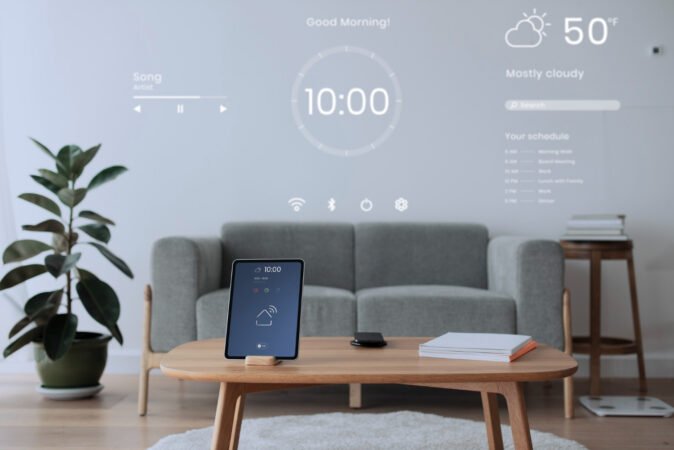As people age, they may find it difficult to maintain their independence and stay in their homes. Smart home automation can help seniors to live safely and comfortably in their own homes for longer. Smart home automation offers a range of technological advancements that can significantly enhance the quality of life for older adults while allowing them to remain in the comfort of their own homes.
The Benefits of Smart Home for Aging in Place

There are many benefits to using home automation for aging in place.
The most important benefits include:
Increased safety:
Smart home can help to keep seniors safe by providing features such as fall detection, medication reminders, and door and window sensors. Smart devices like motion sensors, smart doorbells, and surveillance cameras can monitor the home and alert both the residents and their caregivers or family members in case of any unusual activities or emergencies.
Improved security:
Home automation can also help to improve security by providing features such as remote access, motion sensors, and door locks. This real-time monitoring can prevent accidents, intrusions, or potential hazards, granting peace of mind to both seniors and their loved ones.
Enhanced convenience:
Smart home can make life more convenient for seniors by providing features such as voice control, remote thermostat control, and automated light dimming. Smart home automation allows caregivers or family members to remotely monitor the well-being of their aging loved ones. With the help of smart sensors and connected devices, they can check on daily activities, such as whether the person has taken their medication, moved around the house, or opened the refrigerator. In case of any irregularities, prompt assistance can be provided, even from a distance, ensuring that seniors receive timely help when needed.
Health Monitoring:
Smart home technology also offers health monitoring capabilities. For example, smartwatches or health tracking devices can monitor heart rate, sleep patterns, and other vital signs. This data can be shared with healthcare professionals, enabling timely intervention and personalized care plans. Smart home thus plays a significant role in improving healthcare outcomes for aging individuals.
Energy Efficiency:
Smart home can lead to more energy-efficient living. Automated thermostats and lighting systems can optimize energy consumption, resulting in reduced utility bills. For seniors on fixed incomes, these savings can make a meaningful difference in their finances and make aging in place a more sustainable option.
Reduced isolation:
Smart home can help to reduce isolation by providing features such as video chat, remote monitoring, and social media integration.
If you are a senior or you are caring for an aging loved one, you may want to consider using smart home automation to help them stay safe, secure, and comfortable in their own home.
Examples of how smart home automation can be used to benefit seniors:
- Fall detection: A fall sensor can be placed on the floor in a senior’s bedroom or bathroom. If the sensor detects a fall, it will send an alert to a caregiver or emergency services.
- Medication reminders: A medication dispenser can be programmed to dispense medication at specific times. The dispenser can also send reminders to the senior to take their medication.
- Door and window sensors: Door and window sensors can be used to track when a senior enters or leaves their home. This can help to ensure that the senior is safe and that their home is secure.
- Remote access: A senior can use a smartphone or tablet to remotely control their smart home devices. This allows them to control their lights, thermostat, and other devices from anywhere.
- Voice control: A senior can use voice commands to control their smart home devices. This can be helpful for seniors who have difficulty using a smartphone or tablet.
- Video chat: A senior can use video chat to stay in touch with family and friends. This can help to reduce isolation and loneliness.
Cost of a Smart Home Automation for aging in place:
| Device | Cost | Installation Cost | Total Cost |
|---|---|---|---|
| Fall detection sensors | $50 – $200 | $50 – $100 | $100 – $300 |
| Medication dispensers | $100 – $500 | $100 – $200 | $200 – $700 |
| Door and window sensors | $20 – $50 | $20 – $50 | $40 – $100 |
| Remote access devices | $50 – $200 | $50 – $100 | $100 – $300 |
| Voice control devices | $50 – $200 | $50 – $100 | $100 – $300 |
Total Cost:
- For a basic system: $300 – $900
- For a mid-range system: $600 – $1,500
- For a high-end system: $1,000 – $3,000
Overall, the cost of home automation for aging in place can be a significant investment. However, the benefits of this type of system can be well worth the cost. Smart home can help to keep seniors safe, secure, and comfortable in their own homes.
Tips for saving money:
- Start small: You don’t need to install every smart home device on the market. Start by installing a few devices that you think will be most beneficial to the senior.
- Make it easy to use: The smart home devices you choose should be easy for the senior to use. They should be easy to set up and they should have clear instructions.
- Be flexible: Smart home technology is constantly evolving. As new devices and features become available, you may want to update your system.
Smart home can be a great way to help seniors live safely and comfortably in their own homes. By considering the benefits and limitations of smart home technology, you can choose the right system for your loved one.
“Your feedback helps us understand what you are looking for in a blog post and how we can improve our content. We appreciate your time and effort in taking the time to leave a comment or share our blog post.”
FAQs
- What are the benefits of smart home automation for aging in place?
- Increased safety
- Improved security
- Enhanced convenience
- Reduced isolation
- What are some of the most common home devices for aging in place?
- Fall detection sensors
- Medication dispensers
- Door and window sensors
- Remote access devices
- Voice control devices
- What is the cost of smart home automation for aging in place?
- Varies depending on devices, size of home, and complexity of system
- In general, expect to pay anywhere from a few hundred dollars to several thousand dollars
- What are some tips for saving money on smart home automation for aging in place?
- Start small
- Shop around
- Consider used devices
- Do-it-yourself
- What are some of the challenges of using smart home automation for aging in place?
- Technology can be complex
- Devices can be expensive
- Privacy concerns
If you enjoyed this post, you might also like
How to Control Your Smart Home Automation from Anywhere?
How to Set Up Smart Home Automation on a Budget?
The Pros and Cons of Smart Home Automation: Is It Right for You?

